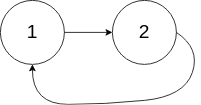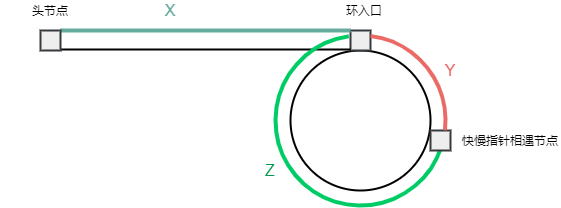给定一个链表,返回链表开始入环的第一个节点。 从链表的头节点开始沿着 next 指针进入环的第一个节点为环的入口节点。如果链表无环,则返回 null。
为了表示给定链表中的环,我们使用整数 pos 来表示链表尾连接到链表中的位置(索引从 0 开始)。 如果 pos 是 -1,则在该链表中没有环。注意,pos 仅仅是用于标识环的情况,并不会作为参数传递到函数中。
说明:不允许修改给定的链表。
示例 1:
输入:head = [3,2,0,-4], pos = 1 输出:返回索引为 1 的链表节点 解释:链表中有一个环,其尾部连接到第二个节点。
示例 2:
输入:head = [1,2], pos = 0 输出:返回索引为 0 的链表节点 解释:链表中有一个环,其尾部连接到第一个节点。
示例 3:
输入:head = [1], pos = -1 输出:返回 null 解释:链表中没有环。
提示:
- 链表中节点的数目范围在范围
[0, 104]内 -105 <= Node.val <= 105pos的值为-1或者链表中的一个有效索引
进阶:是否可以使用 O(1) 空间解决此题?
注意:本题与主站 142 题相同: https://leetcode.cn/problems/linked-list-cycle-ii/
我们先利用快慢指针判断链表是否有环,如果有环的话,快慢指针一定会相遇,且相遇的节点一定在环中。
如果没有环,快指针会先到达链表尾部,直接返回 null 即可。
如果有环,我们再定义一个答案指针
为什么这样能找到环的入口节点呢?
我们不妨假设链表头节点到环入口的距离为
由于快指针速度是慢指针的
也即是说,如果我们定义一个答案指针
时间复杂度
# Definition for singly-linked list.
# class ListNode:
# def __init__(self, x):
# self.val = x
# self.next = None
class Solution:
def detectCycle(self, head: Optional[ListNode]) -> Optional[ListNode]:
fast = slow = head
while fast and fast.next:
slow = slow.next
fast = fast.next.next
if slow == fast:
ans = head
while ans != slow:
ans = ans.next
slow = slow.next
return ans/**
* Definition for singly-linked list.
* class ListNode {
* int val;
* ListNode next;
* ListNode(int x) {
* val = x;
* next = null;
* }
* }
*/
public class Solution {
public ListNode detectCycle(ListNode head) {
ListNode fast = head, slow = head;
while (fast != null && fast.next != null) {
slow = slow.next;
fast = fast.next.next;
if (slow == fast) {
ListNode ans = head;
while (ans != slow) {
ans = ans.next;
slow = slow.next;
}
return ans;
}
}
return null;
}
}/**
* Definition for singly-linked list.
* struct ListNode {
* int val;
* ListNode *next;
* ListNode(int x) : val(x), next(NULL) {}
* };
*/
class Solution {
public:
ListNode* detectCycle(ListNode* head) {
ListNode* fast = head;
ListNode* slow = head;
while (fast && fast->next) {
slow = slow->next;
fast = fast->next->next;
if (slow == fast) {
ListNode* ans = head;
while (ans != slow) {
ans = ans->next;
slow = slow->next;
}
return ans;
}
}
return nullptr;
}
};/**
* Definition for singly-linked list.
* type ListNode struct {
* Val int
* Next *ListNode
* }
*/
func detectCycle(head *ListNode) *ListNode {
fast, slow := head, head
for fast != nil && fast.Next != nil {
slow = slow.Next
fast = fast.Next.Next
if slow == fast {
ans := head
for ans != slow {
ans = ans.Next
slow = slow.Next
}
return ans
}
}
return nil
}/**
* Definition for singly-linked list.
* class ListNode {
* val: number
* next: ListNode | null
* constructor(val?: number, next?: ListNode | null) {
* this.val = (val===undefined ? 0 : val)
* this.next = (next===undefined ? null : next)
* }
* }
*/
function detectCycle(head: ListNode | null): ListNode | null {
let [slow, fast] = [head, head];
while (fast && fast.next) {
slow = slow.next;
fast = fast.next.next;
if (slow === fast) {
let ans = head;
while (ans !== slow) {
ans = ans.next;
slow = slow.next;
}
return ans;
}
}
return null;
}/**
* Definition for singly-linked list.
* function ListNode(val) {
* this.val = val;
* this.next = null;
* }
*/
/**
* @param {ListNode} head
* @return {ListNode}
*/
var detectCycle = function (head) {
let [slow, fast] = [head, head];
while (fast && fast.next) {
slow = slow.next;
fast = fast.next.next;
if (slow === fast) {
let ans = head;
while (ans !== slow) {
ans = ans.next;
slow = slow.next;
}
return ans;
}
}
return null;
};


